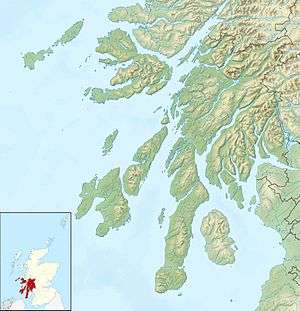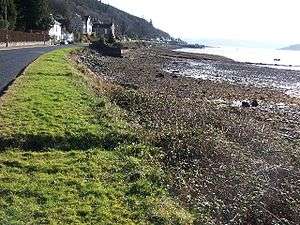Kilmun
| Kilmun Cill Mhunna | |
|---|---|
|
Kilmun looking east along the Holy Loch shoreline towards Strone | |
 Kilmun | |
| Coordinates: 55°59′34″N 4°56′02″W / 55.99278°N 4.93389°WCoordinates: 55°59′34″N 4°56′02″W / 55.99278°N 4.93389°W | |
| Country | Scotland |
| Population (2001) | |
| • Total | 1,030 |
Kilmun (Scottish Gaelic: Cill Mhunna) is a linear settlement on the north shore of the Holy Loch, on the Cowal Peninsula in Argyll and Bute, Scottish Highlands. It runs between the head of the loch and connects with the village of Strone at Strone Point, where the loch joins the Firth of Clyde.
As a settlement, Kilmun is substantially older than most of its neighbours (see Parish Church below). Like them, it developed as a watering-place (a pleasure resort/spa) for Glasgow merchants after 1827, when a quay was built by the marine engineer David Napier. It was a regular stop for the Clyde steamer services until its closure in 1971.[1]
Kilmun is also home to an extensive arboretum managed by the Forestry Commission. Established in the 1930s to monitor the success of a variety of exotic tree species in the humid west coast environment, it includes specimens of Sequoia, Japanese Larch, Araucaria araucana (monkey puzzle) and Japanese Chestnut amongst many others from around the world. A series of woodland walks have been established of varying gradients and degrees of difficulty.
Decline
The population for the Benmore and Kilmun area was recorded as 1,030 in the 2001 census. That showed a decline of 99 people (9.69%) in the ten years since the 1991 census.[2]
Notable residents
Scottish-born Australian politician Gregor McGregor was born in Kilmun.
See also
References
- ↑ Walker, Frank Arneil (2000) The Buildings of Scotland: Argyll and Bute, Penguin.
- ↑ Loch Lomond & The Trossachs National Park
External links
| Wikimedia Commons has media related to Kilmun. |
- Kilmun Origins
- Arboretum details
- Map sources for Kilmun

